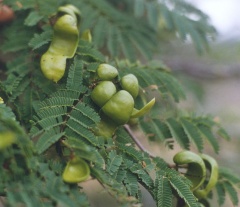Difference between revisions of "Divi-Divi"
| Line 1: | Line 1: | ||
{{Infobox_Other_organic | {{Infobox_Other_organic | ||
| image = Divi-Divi.jpg | | image = Divi-Divi.jpg | ||
| − | | origin = | + | | origin = Caribbean, Mexico, Central America and Northern South America |
| stowage factor = - | | stowage factor = - | ||
| humidity and moisture = - | | humidity and moisture = - | ||
| ventilation = - | | ventilation = - | ||
| − | | risk factors = | + | | risk factors = See text |
}} | }} | ||
==Description== | ==Description== | ||
| − | An extract from the dried pods of the Divi-Divi tree used in the tanning and dyeing industries. Slow drying of pods allows fermentation to commence with production of red colouring matter which diminishes the value of the commodity. | + | Caesalpinia coriaria is a leguminous tree or large shrub native to the Caribbean, Mexico, Central America, and northern South America. Common names include Divi-divi, Cascalote, Guaracabuya, Guatapana, Nacascol, and Watapana (Aruba).<br><br> |
| − | + | C. coriaria rarely reaches its maximum height of 9 m because its growth is contorted by the trade winds that batter the exposed coastal sites where it often grows. In other environments it grows into a low dome shape with a clear sub canopy space. Leaves are bipinnate, with 5-10 pairs of pinnae, each pinna with 15-25 pairs of leaflets; the individual leaflets are 7 mm long and 2 mm broad. The [[fruit]] is a twisted pod 5 cm long.<br><br> | |
| + | The Divi-divi is one of the more well known species of Caesalpinia; it is the national tree of Curaçao. It is also very common and popular on Aruba.<br><br> | ||
| + | Tannins are extracted from Divi-divi pods for use in [[leather]] production.<br><br> | ||
| + | Among the molecules isolated is corilagin, whose name comes from the specific epithet of the plant.<br><br> | ||
| + | ==Application== | ||
| + | An extract from the dried pods of the Divi-Divi tree used in the tanning and dyeing industries. Slow drying of pods allows fermentation to commence with production of red colouring matter which diminishes the value of the commodity. High value pods are fleshy and white in colour. Those of dark colour with spots and blotches, have probably been damaged by moisture or picked in damp condition. This greatly reduces the value. <br><br> | ||
| + | ==Shipment / Storage== | ||
| + | Stow away from foodstuffs.<br><br> | ||
| + | ==Risk factors== | ||
| + | Liable to infestation. | ||
| + | |||
| + | [[Category:Products]] | ||
[[Category:Other organic material]] | [[Category:Other organic material]] | ||
| − | |||
Revision as of 10:48, 15 April 2013
| Infobox on Divi-Divi | |
|---|---|
| Example of Divi-Divi |  |
| Facts | |
| Origin | Caribbean, Mexico, Central America and Northern South America |
| Stowage factor (in m3/t) | - |
| Humidity / moisture | - |
| Ventilation | - |
| Risk factors | See text |
Divi-Divi
Description
Caesalpinia coriaria is a leguminous tree or large shrub native to the Caribbean, Mexico, Central America, and northern South America. Common names include Divi-divi, Cascalote, Guaracabuya, Guatapana, Nacascol, and Watapana (Aruba).
C. coriaria rarely reaches its maximum height of 9 m because its growth is contorted by the trade winds that batter the exposed coastal sites where it often grows. In other environments it grows into a low dome shape with a clear sub canopy space. Leaves are bipinnate, with 5-10 pairs of pinnae, each pinna with 15-25 pairs of leaflets; the individual leaflets are 7 mm long and 2 mm broad. The fruit is a twisted pod 5 cm long.
The Divi-divi is one of the more well known species of Caesalpinia; it is the national tree of Curaçao. It is also very common and popular on Aruba.
Tannins are extracted from Divi-divi pods for use in leather production.
Among the molecules isolated is corilagin, whose name comes from the specific epithet of the plant.
Application
An extract from the dried pods of the Divi-Divi tree used in the tanning and dyeing industries. Slow drying of pods allows fermentation to commence with production of red colouring matter which diminishes the value of the commodity. High value pods are fleshy and white in colour. Those of dark colour with spots and blotches, have probably been damaged by moisture or picked in damp condition. This greatly reduces the value.
Shipment / Storage
Stow away from foodstuffs.
Risk factors
Liable to infestation.











